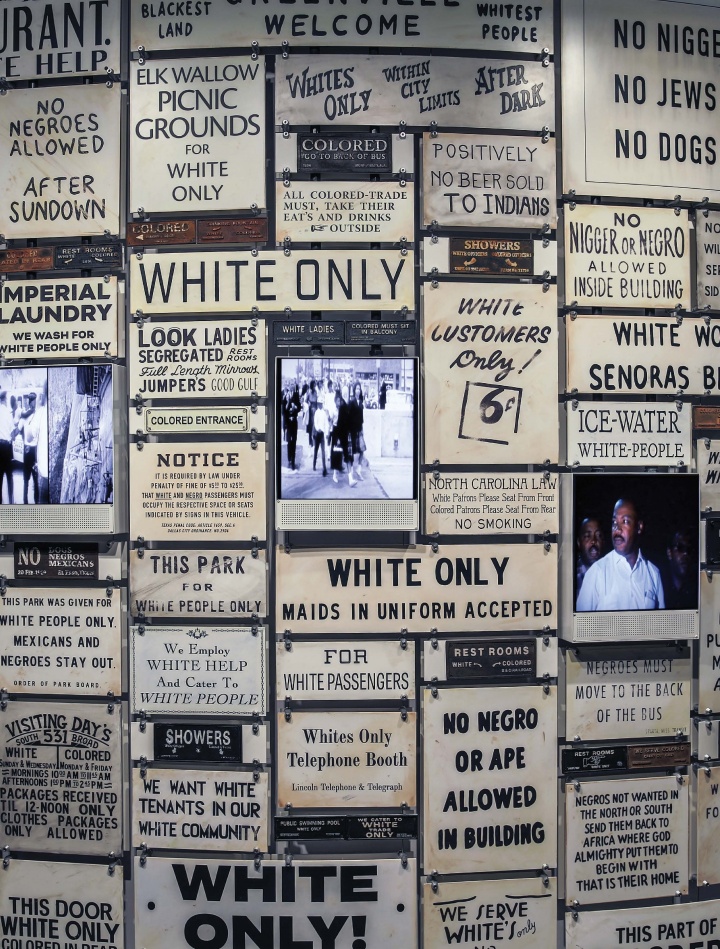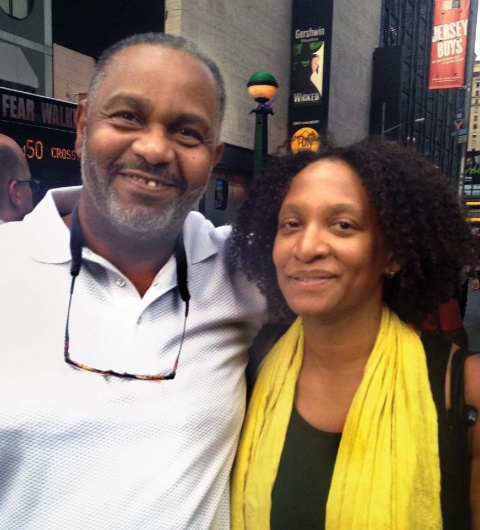For Cathleen Price ’92 and the Equal Justice Initiative, confronting the past is essential to righting its wrongs today.
Columbia College | Columbia University in the City of New York
For Cathleen Price ’92 and the Equal Justice Initiative, confronting the past is essential to righting its wrongs today.

Jörg Meyer
“The article definitely struck a chord with me,” Price remembers. She had studied the history of the Deep South in class, including the injustices so many had faced, and still faced. But Stevenson’s work also spoke to her on a personal level. “My parents’ roots are in Mississippi and Louisiana,” she says, “so I had learned about the lived experience of racism and injustice from my family history and sense of identity, as well. What I was reading hit me with great immediacy and familiarity.”
She couldn’t have known it then, but Stevenson and his fledgling organization — which evolved into the nationally renowned, Montgomery, Ala.-based Equal Justice Initiative — would become the heart of her professional career.
Price did internships there as a student at Harvard Law School, and turned down offers from white-shoe law firms in New York to join EJI full-time in 1997. “Cathleen came to Montgomery at a time when it was not fashionable for people from elite legal institutions to come to the Deep South and do this work,” Stevenson says. “She helped build a foundation on which much of our work over the last 15 years has been able to grow and expand.”
Through the years, EJI has provided representation to thousands of poor, incarcerated and condemned clients and mounted important legal challenges to racial discrimination in the criminal justice system. Stevenson himself has become a social justice icon. His bestselling memoir, Just Mercy: A Story of Justice and Redemption, was recently adapted into a Hollywood docudrama starring Michael B. Jordan as the young Stevenson and Jamie Foxx as his wrongly convicted death-row client, Walter McMillian.
Asked to describe her longtime mentor and colleague, Price doesn’t mention charisma or star power, however. “The first word that comes to mind is humble,” she says. “And the second, which is more reflective but no less meaningful to me, is rigor — the rigor of one’s work, and one’s commitment, the rigor in which you hold yourself accountable.” She adds, warmly, “Knowing Bryan has been one of my life’s blessings.”
Price left the full-time EJI staff in 2007, but has continued to work closely with her colleagues there in a consulting role while maintaining a private practice in appellate law; teaching an undergraduate seminar at the College on race, poverty and criminal justice; and assisting Stevenson in a clinical law program at NYU, where he is a full professor. Asked what he would say about Price to someone who never met her, Stevenson is effusive: “I’d say that you’re going to be so blown away by this smart, talented, thoughtful, creative person, who will engage you in conversation about anything and have a really informed and insightful perspective to share,” he says. “She’s incredibly dynamic and the kind of person that once you meet, you don’t forget.”
Price’s legal specialty is death penalty appeals, mostly stemming from Southern states with long histories of capital punishment meted out arbitrarily or unfairly, particularly if the defendant is poor, Black, falsely accused or inadequately represented. Appeals can go on for years, with soul-wrenching ups and downs. For a lawyer, this can be difficult, grinding work, requiring an unusual skill set. “You have to be able to deal with death-row prisoners, Alabama prison guards, expert witnesses, federal judges, prosecutors,” says Robert Amdur, associate director of Columbia’s Center for American Studies and an adjunct associate professor of political science, who has known Price for 30 years. “It takes a real talent and a real psychological acuity.”
As with mass incarceration, the roots of death-row injustice run deep — back to the eras of enslavement, convict leasing and racial terror. Capital punishment is “a stepchild of lynching,” Stevenson has said.
“My father’s father was born a slave, so I’m only two generations from slavery.”
“Why do some states have the death penalty and not others?” asks EJI deputy director Randy Susskind, who has worked closely with Price. “Why did this person get selected to be on death row? I mean, there are hundreds and hundreds of murders a year in a state, and yet only a handful are on death row? How did we get to this place?”
Price wrestles with those questions every day as an advocate and teacher.
“If you want to understand criminal justice and therefore have a coherent and comprehensive concept of reform,” she says, “you do need to understand why we do the things we do, why certain crimes are traditionally overly punished while others are considered matters that you could be rehabilitated around. And that goes right back to the construction of race in order to justify slavery in what was otherwise supposed to be a free country. The way all of that continues to play out in our criminal justice system is very raw.”
Montgomery is a quiet city that nonetheless thrums with the passion of America’s racial struggles, past and present. It was the first capital of the Confederate States; a statue of Jefferson Davis still stands tall before the imposing Alabama State Capitol building, where Gov. George C. Wallace gave his defiant “segregation forever” inaugural address in 1963, calling this place the “very heart of the great Anglo-Saxon Southland.” Yet Montgomery also cradled the civil rights movement: Rosa Parks, the bus boycott, the Freedom Riders and the emergence of Martin Luther King Jr. The last voting rights march from Selma in 1965 culminated in a mass rally at the State Capitol, electrified by King’s oratory. Rep. John Lewis lay in state there after his funeral procession in late July.


(Top) A chilling sculpture at, and (above) one section of, The National Memorial for Peace and Justice, which commemorates some 4,400 Black victims of lynching between 1877 and 1950.
PHOTOS COURTESY EQUAL JUSTICE INITIATIVE ∕ HUMAN PICTURES
The main memorial is dominated by hundreds of oblong slabs that hang suspended from the ceiling, each one engraved with the victims’ names and the dates of lynching in a single county. The symbolism is chilling, calling forth an echo of terror that does not feel safely past, even while respecting the significance of each individual life and acknowledging the trauma visited on their families and communities. It is a place of solemnity and reflection, a space where visitors of all races are visibly moved.
EJI has engaged in an exhaustive research project documenting the atrocities, even to the point of collecting soil from known lynching sites. “This is soil containing the blood and the sweat of the enslaved people, the tears of people who were lynched, the tears of people who experienced the indignity of segregation,” says Sade Stevens, an EJI Justice Fellow from South Africa, pointing to hundreds of earth-filled jars collected from the sites. “So there really is that tangible piece through which we can trace the history.”
That history and those emotions were close at hand for Price when she attended the dedication ceremony in 2018.

Signs of Jim Crow, inside The Legacy Museum.
Almost in passing, Price mentions another connection. A member of her own family was lynched in Louise, Miss., in 1962.
“My father’s first cousin, Eddie Davis Jr. He was decapitated on the side of the road,” she says. “It was a trauma that was sort of unspeakable within the family. I remember asking my father about it and he wouldn’t really talk about it.”
Price was born and raised in Denver, the youngest of three children of Calvin and Naomi Price; both are now deceased. He was a Korean War veteran and civil engineer who worked for the federal government; she was a registered nurse from a Louisiana family that migrated before WWI to Chicago’s South Side, where the Prices lived before moving to Colorado. “Both my parents were raised very poor, but my mother was ‘city poor’ — she was a little better off.”
The family’s majority-white, Southeast Denver neighborhood was a far cry from Chicago’s South Side.“It was a new suburb. There were large fields and a horse farm nearby,” Price says. She paints her childhood in generally happy colors, despite some racial tensions around the issue of school integration and busing. Hers was a musical household, where Duke Ellington and Count Basie reigned; they remain favorites to this day. Price herself was “very bookish,” she says. “I used to read voraciously, is the positive term. But I think it was actually defensively. I would sort of disappear into books. I was kind of lonely. Spent a lot of time at the library.”
All that reading helped propel her to the top rung of her class at Thomas Jefferson H.S., where she played volleyball and competed in track while working part-time as a babysitter, housekeeper and restaurant hostess. Price also interned at the Denver district attorney’s office, where she witnessed two capital trials, her first brush with death-penalty matters. She pushed herself hard in high school, she says. “I definitely was raised in a home where you needed to have a plan.”
Her plan was to attend a top-tier college in a major city, and she looked into options from coast to coast. “I got an admissions videotape from Penn with Donald Trump on the cover,” she recalls. But Columbia paid her way to a minority recruitment weekend on campus, and she was sold.
“I think that I was genuinely educated at Columbia, and I’m grateful,” she says. “It’s a good place for oddballs,” she adds, not excluding herself from the category. “There was quite a bit of nonconformity, but it wasn’t actually pretentious conformist nonconformity. It was kind of a place for people who felt really awkward at the high school Homecoming.”
Price especially appreciated her classes with historians Eric Foner ’63, GSAS’69, Barbara Fields and Elizabeth Blackmar, and with Marcellus Blount, in English. Law School professor Kendall Thomas hired her as a research assistant; she credits him with sharpening her ability to think clearly. “I’m not sure I was that helpful to him,” she says. “But I learned so much, and he was so patient with my mistakes.”

Price and Anthony Ray Hinton, whom she helped exonerate after 30 years in prison.
The McNair case was her baptism into many aspects of her life’s work. “I kind of learned how to be a lawyer with him,” Price says. “Not the technical part, not the substantive part. But you’re sort of walking a road with a client. They don’t teach you how to do that in law school.”
Price grew close to McNair and members of his family. At one point, his aunt said to her, “I just want to thank you for holding on.” The experience still gnaws at her.
There are victories, too. Price was on one of the successive teams that gained freedom for Anthony Ray Hinton after 30 years in prison, most of them on death row, for a crime he did not commit. Today he is a successful author and public speaker who works in community education for EJI, and a close friend of Price. His guest appearances at her College seminar are a revelation for students, she says.
Teaching and learning are close to the heart of Price’s work at EJI, too. One of her important roles there has been mentoring younger staff members.
“Cathleen is a model for what it means to be an attorney doing this work, in terms of the seriousness, and professionalism, and gravity, and just the hard work that is required,” says Charlotte Morrison, a senior attorney from Montana and former Rhodes Scholar who joined EJI in 2001. “As a young student coming into an office with lawyers like that, you just very quickly learned what was at stake. This wasn’t about your own career path or your own identity — it was always directly linked to the lives that you were serving. That is the culture that Cathleen embodied and passed down to all the students like me who worked with her.”
Price’s life isn’t all about work, though that’s never too far away, it would seem. For one thing, she has a deep love of jazz, and keenly misses going out to New York’s great clubs, now shuttered because of the pandemic. Then there is her pursuit of culinary serendipity.
“We’ve spent a lot of time on the road,” Stevenson says. “She is a serious, serious foodie. I mean, at levels that are not easily managed by many people. Even after a long day of investigation or spending a lot of hours in a prison, she was always up for a small adventure if the best biscuits, fried chicken and collard greens were the rewards for that.”
This was no small thing, he believes.
“It’s great to have someone who was unafraid to explore all of the details of a cultural environment. We did some cases with really isolated poor Black families in the Deep South, and she was not only comfortable, but also was respectful and curious about how to learn more from the people we served. She helped us appreciate that this work is not just our struggle,” he says, “it’s also our life.”
Former CCT editor Jamie Katz ’72, BUS’80 has held senior editorial positions at People, Vibe and Latina magazines and contributes to Smithsonian Magazine and other publications.

Published three times a year by Columbia College for alumni, students, faculty, parents and friends.
Columbia Alumni Center
622 W. 113th St., MC 4530, 6th Fl.
New York, NY 10025
212-851-7852
cct@columbia.edu

Columbia Alumni Center
622 W. 113th St., MC 4530, 4th Fl.
New York, NY 10025
212-851-7488
ccalumni@columbia.edu